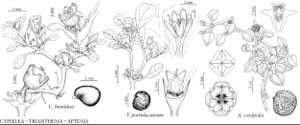Cypselea humifusa
Ann. Mus. Natl. Hist. Nat. 7: 219, plate 121. 1806.
IntroducedIllustrated
Treatment appears in FNA Volume 4. Treatment on page 82.
Mats leafy, to 10 cm wide. Stems diffusely branched from base. Leaves: unequal pairs alternating, usually subtending fascicle of leaves; petiole slender, ± equaling blade length; blade apex obtuse; larger blade of pair 0.5(–1.2) cm, smaller blade 0.2(–0.6) mm. Inflorescences: flowers in axils of smaller leaves (bracts) between short lateral stem and main stem; bracteoles 2; pedicel 2 mm. Flowers: calyx lobes erect, ovate, to 1.5 mm, margins scarious, fringed, apex obtuse. Capsules subglobose, membranous. Seeds red-brown, ± round-reniform or subtriangular, asymmetric, 0.3 mm, smooth.
Phenology: Flowering summer–fall.
Habitat: Moist, seasonally flooded, or seasonally dry, open mud or sand flats, banks, shores, and margins of ponds, lakes, canals, and rivers
Elevation: 0-1000 m
Distribution
Introduced; Ariz., Calif., Fla., La., Miss., Nev., West Indies, South America.
Discussion
Selected References
None.
Lower Taxa
None.
